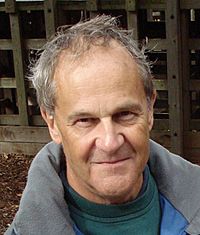Roger Carpenter facts for kids
Quick facts for kids
Roger Carpenter
|
|
|---|---|

Roger Carpenter
|
|
| Born | 2 September 1945 |
| Died | 27 October 2017 |
| Nationality | English |
| Citizenship | British |
| Alma mater | University of Cambridge |
| Known for | publications |
| Scientific career | |
| Institutions | Cambridge |
Roger Hugh Stephen Carpenter (born September 2, 1945, died October 27, 2017) was a clever English scientist. He was a Professor at the University of Cambridge. He studied how our brains work, especially how our eyes move. This field is called neurophysiology and oculomotor physiology.
Contents
Early Life and Education
Roger Carpenter went to Gresham's School in Holt, Norfolk, when he was young. After that, he studied at the famous University of Cambridge.
Roger Carpenter's Career
Before becoming a professor at Cambridge, Roger Carpenter worked at Caius College. He was in charge of medical studies there. He was very interested in how our minds make decisions.
He created special computer programs. One was called EPIC (Experimental Physiology Instrumentation Computer). The other was NeuroLab. These programs helped people learn about the human brain.
In his free time, he also helped with a project called CUDOS. This project helped medical students use their gap year wisely. He also directed music groups, like the Susato Consort.
In 2000, Roger Carpenter won a special award. He received £50,000 for his excellent teaching. This was from the Institute for Learning and Teaching in Higher Education.
What Roger Carpenter Studied
Roger Carpenter mainly focused on how we make decisions. He studied saccadic latency. This is the time it takes for our eyes to choose something to look at. It's also the time it takes to start moving our eyes.
His work led to a model called LATER. This model helps explain how our brains make quick decisions. New technology made it easier to study eye movements. These studies have helped doctors in many ways. He also studied vision, how our bodies move, and how our minds are aware of things.
Roger Carpenter once described himself as a "Philosopher, mad scientist, and artiste extraordinaire." This shows he had a fun and creative side!
Important Publications
Roger Carpenter wrote many scientific papers and books. Here are a few examples of his important work:
- Genest, W., Hammond, R. & Carpenter, R. H. S. (2016). The random dot tachistogram: a novel task that elucidates the functional architecture of decision. This paper looked at how we make decisions using a special test.
- Noorani, I. & Carpenter, R. H. S. (2016). The LATER model of reaction time and decision. This explained his famous LATER model in more detail.
- Carpenter, R. H. S., Reddi, B. A. J. (2012). Neurophysiology: A Conceptual Approach. This was a textbook that helped students understand how the nervous system works.
- Carpenter, R. H. S. & Williams, M. L. L. (1995). Neural computation of log likelihood in the control of saccadic eye movements. This paper was published in the famous journal Nature. It showed how the brain controls eye movements.
- Carpenter, R. H. S. (1988). Movements of the Eyes. This was an important book about how our eyes move.

